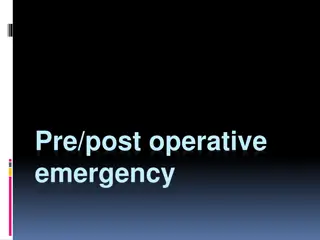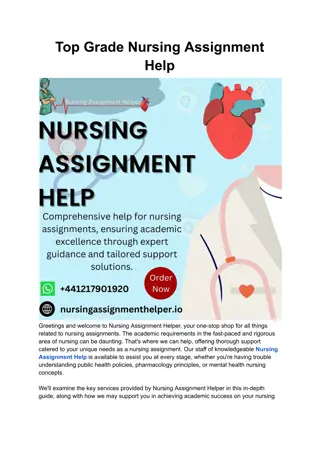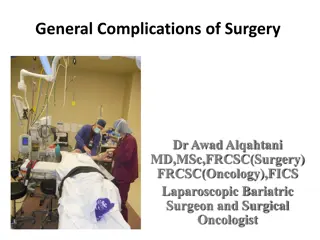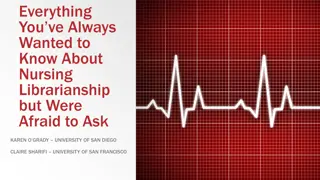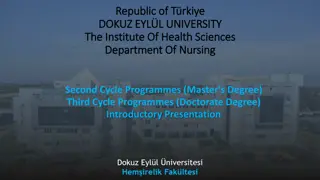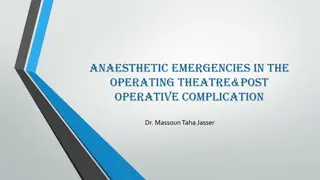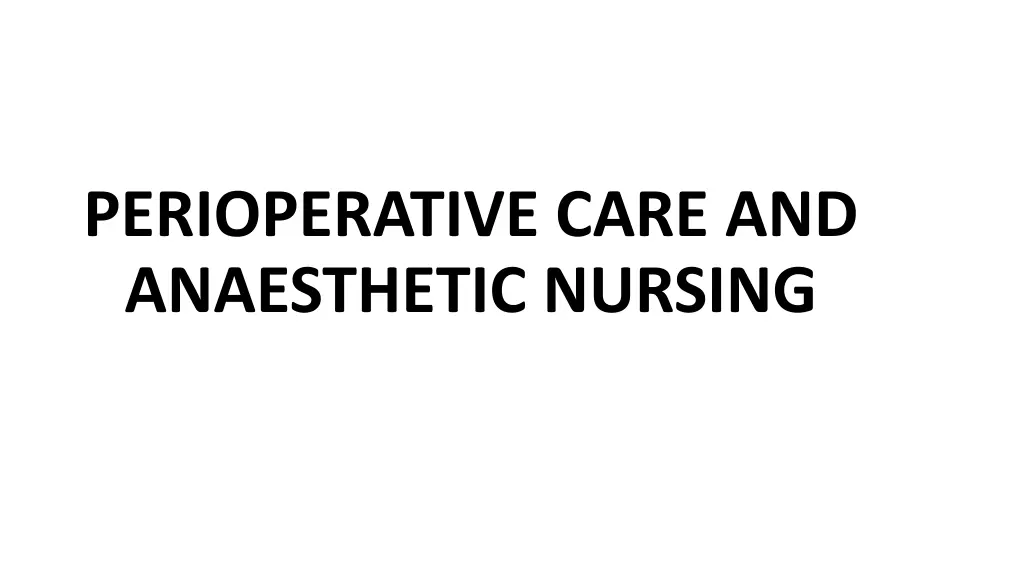
Theatre Nursing: Historical Background and Roles
Explore the fascinating history of theatre nursing, from ancient surgical practices to modern advancements. Learn about the evolution of anaesthesia, infection prevention methods, and the crucial role of theatre nurses in ensuring safe patient care during surgical procedures.
Download Presentation

Please find below an Image/Link to download the presentation.
The content on the website is provided AS IS for your information and personal use only. It may not be sold, licensed, or shared on other websites without obtaining consent from the author. If you encounter any issues during the download, it is possible that the publisher has removed the file from their server.
You are allowed to download the files provided on this website for personal or commercial use, subject to the condition that they are used lawfully. All files are the property of their respective owners.
The content on the website is provided AS IS for your information and personal use only. It may not be sold, licensed, or shared on other websites without obtaining consent from the author.
E N D
Presentation Transcript
PERIOPERATIVE CARE AND ANAESTHETIC NURSING
Module Objectives By the end of this unit you will be able to; Describe the historical background of theatre nursing; Explain the legal requirements to be met by an operating theatre; Describe the general layout of the operating theatre; Describe the instruments used in a theatre; Describe the methods of ensuring safety and infection prevention in the theatre; Explain the Roles and functions of the theatre Nurse in the care of a patient while in theatre;
HISTORY OF THEATRE NURSING Theatre nursing has developed alongside the history of surgery Surgery is an old form of treatment that can be traced back through the history of man. In the past, there were no theatres, no trained personnel, no anaesthesia and no equipment. Operations were performed at home. Problems during this time included infection, bleeding and pain. However, with time, efforts were made to solve these problems. For example, in 17 BC, alcohol and opium were used to relieve pain by Napoleon who performed an amputation while the patient slept for 24 hours.
By 1772, Joseph Priestly discovered the use of nitrous oxide as anaesthesia, In 1842, Dr Crawford discovered the use of ether. In 1847 James Young began to use chloroform. In the 18th century a great breakthrough was made with the use of trilene, thiopentone, clytopopaine and curare, which are muscle relaxants. By the end of 19th century, pain relief was an integral part of surgery. In order to control haemorrhaging, the ancient Greeks and Romans as far back as the 16th century BC, used strings as ligatures. Later on, during the Middle Ages, they came up with the use of hot iron This idea has been developed into the use of cautery to control bleeding.
By the beginning of the 20th century, many types of ligatures were available, prepared from metal, nylon and cotton. The control of infection dates back to the efforts of Louis Pasteur, who proved that bacteria caused infections. In 1865, Joseph Lister used carbonic acid to reduce the growth of bacteria in wounds. In 1886 Von Bergemen introduced sterilisation of dressings. Gloves were introduced in surgery in 1890.
Theatre nursing Theatre nursing is as old as nursing A theatre nurse is a member of a bigger team, all of whom work together to provide a safe passage through the operating theatre for every patient. Theatre team includes ( the nurse, anaesthetist, surgeon, theatre assistant) However small or insignificant the task to be performed, the theatre nurse is responsible for the success of the procedure. They must, therefore, be highly skilled and trained, in order to be able to ensure a successful outcome for the patient.
Aims of theatre nursing To prepare conscientiously by study to adapt to the changing world of medicine, To allay the fears of the patient, To integrate the patient care during their period in theatre, To become highly skilled in theatre techniques, To be able to impart knowledge to others,
Preoperative Care Preoperative evaluation 1. Complete history and Proper documentation; ie menstrual , reproductive , sexual ,allergies ,chronic conditions etc 2. Clinical examination-general head to toe, vital signs, weight, height ,and systems review. 3. Investigations Full Haemogram, Urea and electrolyte ,LFT S GXM,RBS, ETC.
Preoperative Care 4. You should make sure that the surgeon explains clearly to the patient what will happen to them. 5. The surgeon should obtain an informed consent from the patient or parent/guardian/next of kin for those under age 18 in Kenya or not in a position to sign (e.g. unconscious person, mentally ill ). 6. The nurse ensures that the patient has signed an informed consent, after the surgeon has explained the advantages and outcomes of the operation. 7. Make sure that the patient observes a Nil by oral rule.
Pre-operative care 8. The fasting should usually start six hours before the operation. 9. Blood works: All should be within the acceptable ranges e.g. full Haemogram including HB, urea, electrolytes and creatinine. 10. The patient should be counselled and reassured especially those receiving operations such as amputation, or mastectomy 11.The site to be operated on should be shaved of hair and cleaned with warm soapy water, to reduce the bacteria on the patients skin. The area shaved should be larger than the incision site.
ct 12. Catheterisation and IV branula insertion may be necessary depending on the surgery. 13. Observations of vital signs, urine testing for sugars, proteins and acetone should be done, some of the requirements form some of the legal aspects before surgery.
PREOPERATIVE PREPARATION OF PTS Manage and treat/stabilize any pre existing medical condition Give up smoking 6/52 or at least over 48 hours to reduce carboxyl haemoglobin Pre anaesthetic review Drug history Preoperative counseling Patient has a right to know the extend and risks of any intended surgery, An outline of the immediate postoperative recovery
Legal Aspects in Theatre Nursing legal . The dictionary defines the word legal as 'required or 'permitted by law'. Therefore, when we talk of legal aspects in theatre nursing, we are referring to what the law requires us to do in the theatre before, during and after the operation.
Important considerations 1. Right to life/principle of justice 2. Respect of autonomy-respect to ones opinion 3. Principle of non maleficence do no harm (beneficence) COMMON ENCOUNTERED LEGAL ISSUES Consent, Negligence, inadequate documentation, inexperience, clinical errors, confidentiality, patients security. 1. Consent: Consent must be: Legally valid e.g. given by a person above 18 years, of sound mind and voluntary not coerced Administered by a competent doctor Must be informed
2. Negligence: clinician not providing adequate /reasonable information about risks of proposed treatment. 3. Inadequate documentation: improper and incomplete notes, lack of documentation. 4. Inexperience /inadequate experience/lack of experience: No clinician is an expert of everything, clinician should seek appropriate guide,/supervision and refuse to proceed. 5. Clinical errors (not negligence) clinician need to be honest and apologetic for their mistakes ,this is not admitting negligence. Patients accept apologies but not explanations.
6. The importance of confidentiality in nursing practice was stressed. This is another legal requirement. In the definition of legal, the term permitted by law implies that you can only carry out patient care within what the law permits you to do. Therefore, the law gives the patient seeking medical, surgical and nursing care, rights under which they are to be managed.
7. Security/Safety of the patient before, during and after operation is vested in the theatre team. It has already been implied earlier that by signing the consent form, the patient takes some responsibility for the whole loss of life or part of their body. However, this does not take away the responsibility of the theatre team to ensure the security of the patient's life during the operation.
It is on this basis that those below the legal age of adulthood (18 years in Kenya) are not legally bound to sign the consent form. It is signed by the parents/guardians on their behalf. In the same way, consent for the mentally ill is sought from their parents/guardians/relatives. It is also important to note that consent for an operation should be obtained from the patient before they are pre- medicated, as pre-medication drugs have the potential of affecting their reasoning capacity, hence making consent signed not legally binding.
The legal aspect in theatre nursing involves the care of the patient from the time the patient is accepted in theatre, until they are handed over back to the ward. For these reasons, the following procedure should be adhered to: 1. Any patient going to theatre must be properly prepared preoperatively. 2. The patient must be well labelled. 3. The patient must sign an informed consent, obtained by the surgeon. 4. The patient must be protected from any harm, falls or eventuality, during the stay in theatre. 5. Confidentiality must be observed regarding the patient.
5. Measures must be taken to ensure that the patient taken to theatre is the right one for the intended operation. 6. The items to be used for the operation must be counted and recorded before and after operation to prevent loss of swabs, tubes, blades, forceps, abdominal pacts and any instrument used. 7. Theatre nurses must know where the exits are, for use in case of an emergency. 8. Sockets in theatre should be covered during scrubbing to prevent risk of conducting currents. They should also be one meter or more above the floor level. 9. All electrical machines must be checked to ascertain optimum function before use on the patient.
Theatre design considerations The design depends on the : 1. Number, type and length of the surgical procedure to be carried out. 2. Type and distribution of specialties of the surgical team and the equipment required by each. 3. Staff, patients and other personnel safety during construction and renovation. 4. Equipment s and surgical specialty 5. Scheduling policy 6. Volumes- patients and size of the hospital. 7. Planned technology. 8. Future plans expansion.
Design consideration 9. Systems and procedures for efficient patient, staff and supplies flow 10.Scheduling policies related to the number of hours per day and days per week the suit will be in use. 11.Design , ventilation and control of pollution and traffic all need to be considered in the design of the operating room. 12.A proper design of the operating theatre allows a one way flow of traffic and prevents the return flow of contaminants in to the clean area. 13.Operated patient should not meet with the unoperated patient
12. separate areas should be allocated for use Anesthetic room Scrub area Sterile supply area Dirty utility area Sterilizing room Unsterile stock and heavy equipment area Plaster room Receiving area Recovery area Staff lounge Dark rooms for x-ray Changing room and cleaners room Laboratory Operating suite Clean corridors Separation between restricted and semi restricted areas
Design - Theatre light 13.Fluorescent lighting is best for general illumination, with provision for emergency back up (portable light) 14.In patients areas , white light is preferred as blue light will make the patient look cyanosed 15.Over head lights should be shadow less and made of tungsten lamps and incandescent bulbs with heat filters that act as reflectors to prevent over heating of patients and theatre staff. 16.The lights should be dimmed and increased by turning a knob 17.The lights should have an autoclavable handle covers so that the surgeon can adjust the position of the light on the operating site.
size Theatres should be of equal sizes if possible. They should measure 20 by 20 by 10 ft. (L W H, or 400 sq.ft Larger rooms for complicated procedures like cardiac surgery
Wall and ceiling 1. Walls and ceilings should be solid without windows, 2. Finishes of all surface material should be hard, non porous, fire resistant, waterproof, stain proof, seamless, non reflective and easy to clean . 3. The ceiling should be a minimum of 10 feet high and have seamless construction 4. The ceiling colour should be white to reflect at least 90% of the light in even dispersion. 5. Walls should be pastel colour (soft, neutral e.g. baby blue) with paneling made of hard vinyl materials that is easy to clean and maintain. 6. The walls should have stainless cuffs at collision corner to prevent damage.
Floors 1. The floor should be made of antistatic materials. 2. It should be probably made of terrazzo or seamless polyvinyl chloride that is continued up the sides of the wall for about six inches. 3. The material should not degrade or wear out with aging and cleaning. 4. They should be slip-proof when wet 5. It should be easy to clean by flooding or wet vacuum cleaning.
Doors and ventilation Doors: 1. Should about 4ft wide 2. Sliding doors, that can be swung open when necessary 3. They should not remain open during surgical procedures Ventilation: 1. Air movement and air conditioning in the operating theatre are regulated so that the patient and theatre staff are comfortable. 2. Air flow in the operating room is directed clean to less clean areas. 3. Relative humidity is maintained at between 50-55% 4. Heat and water loss can occur in small babies during prolonged operations in cool air conditioning, hence humidity needs to be adjusted
Recirculating air A certain amount of the exhaust air is filtered to remove bacteria and is then re introduced to the operating room. Control of pollution and traffic 1. Anesthetic gases are scavenged from the expiratory valve of the anesthetic machine to the atmosphere via tubing 2. Traffic of personnel is restricted in the operating room 3. A limited number of staffs should be present
Traffic flow 1. Unrestricted area: personnel may wear street cloths, and traffic is not limited. 2. In semi-restricted area: such as processing and storage areas for instruments and supplies, as well as corridors leading to the restricted areas of the surgical suite, personnel must wear surgical attire and patients must wear gowns and hair coverings 3. Restricted area: This includes operating room and clean core and scrub sink areas. Surgical attire and mask are required in these areas when there are open sterile supplies or scrubbed persons in the area.
4. The flow of supplies should from clean core area through the operating rooms to the peripheral corridor. 5. Soiled materials should not re-enter the clean core area
Location 1. Theater should be located in an area accessible to the; Critical Care Unit, Sterile Supplies Area Laboratory Department The Radiology Department 2. A terminal location is necessary to prevent un related traffic from passing through the suite.
Traffic patterns In the restricted areas there are: Open sterile supplies Scrubbed personnel All personnel should wear masks and caps Sterile procedures Semi restricted area: Personnel to wear scrubs/theatre attire, and caps Patients hair should be covered Only authorized personnel
Members Of The Surgical Team The surgeon Anaesthesiologist Nurse manager Receiving area nurse Circulating nurse Scrub nurse
Theatre equipments 1. The operating table 2. The operating lights 3. The anaesthetic machines 4. The anaesthetic cart 5. Sterile instruments 6. Electronic monitor 7. The pulse oximeter machine 8. Automated blood pressure machine 9. An electrocautery machine (Diathermy machine) 10.heart-lung machine 11.Diagnostic imaging systems such as MRI and cardiac catheterization 12.Instruments and patients trolleys 13.Drip stands 14.Laryngoscopes 15.Suction machines 16.autoclave
Basic general instruments 1. Cutting instrument s- scalpel, scissors 2. Holding instrument s- dissecting forceps, sponge holding forceps, towel clips, babcock s tissue holding forceps, tissue forceps, kockers. 3. Clamping instruments- artery forceps. 4. Exposing instruments- Retractors. 5. Suturing instruments- needle holders, suturing forceps toothed and non toothed and ligature scissors.
Maintaining a sterile field/Principles of aseptic technique 1. Placing sterile items within sterile field and only sterile items are used within sterile field 2. Opening, dispensing or transferring sterile items without contaminating them. 3. Not allowing sterile personnel to reach across unsterile areas and touch unsterile items 4. Not allowing unsterile personnel to reach across the sterile field or to touch sterile items.
4. Whatever is sterile for one patient can only be used for that patient. 5. You must pour sterile fluids from a point high enough to prevent accidental touching of the receptacle, but this should not produce splashing. 6. If there is any doubt about the sterility of an article or area, it is considered unsterile 7. Sterile objects become unsterile when touched by unsterile objects. 8. Sterile items that are out of vision or below the waist level of the nurse are considered unsterile. 9. Sterile objects can become unsterile by prolong exposure to airborne microorganisms. 10.The edges of a sterile field are considered unsterile.
11.Gowns of the surgical team are considered sterile in front from the chest to the level of the sterile field. The sleeves are also considered sterile from 2 inches above the elbow to the stockinette cup. 12.Sterile drapes are used to create a sterile field. Only the top surface of a draped table is considered sterile. During draping of a table or patient, the sterile drape is held well above the surface to be covered and is positioned from front to back. 13.A tear or puncture of the drape permitting access to an unsterile surface underneath renders the area unsterile. Such a drape must be replaced. 14.Sterile fields should be prepared as close as possible to the time of use.
15. The movements of the surgical team are from sterile to sterile areas and from unsterile to unsterile areas. 16. Scrubbed persons and sterile items contact only sterile areas; 17. Circulating nurses and unsterile items contact only unsterile areas. 18. Movement around a sterile field must not cause contamination of the field. 19. Sterile areas must be kept in view during movement around the area. At least a 1-foot distance from the sterile field must be maintained to prevent inadvertent contamination. 20. Whenever a sterile barrier is breached, the area must be considered contaminated.
SAFETY AND INFECTION PREVENTION IN THEATRE Safety and infection prevention are of utmost importance in the operating theatre. To ensure this, in this section you will consider the: 1. preparation of the operating theatre, 2. theatre nurse, 3. patient and equipment. 4. The equipment used in theatre and types of anaesthesia.
1. Preparation of the operating room 1. The theatre and equipment must be cleaned thoroughly every morning to minimise the number of micro-organisms. 2. Ensure high dusting of walls and clean trolleys, drip stand, operating tables and all equipment there in. 3. You should also ensure that the floor is scrubbed with soapy water to remove dirt and then mopped with a disinfectant recommended by the hospital. 4. After cleaning and drying the theatre floor, all the equipment must be returned to its proper place and ensure they are working. 5. Prepare the operating table by drying it after cleaning and placing it in the right position directly below the overhead operating lights.
5. Theatre table should then be draped with a clean sheet ready to receive the patient. 6. You should then set the anaesthetic tray ready 7. Check the diathermy machine to ensure it is in working order for use to cauterise any bleeding vessel during operation. 8. The operating lights should be checked to ensure they are in good working order. 9. The required operating set of equipment should be ordered from the theatre sterilising room/unit. 10. After the operation has been completed you should:
10.After the operation you should ensure: Clean all fitments and equipment thoroughly Do high and low level dusting using the disinfectant Clean the floor and drains with the disinfectant Wipe the operating lights with a clean damp towel
2. Preparation Of The Nurse 1. After entering the theatre unit, you should go straight to the changing rooms. 2. Take a shower and change into your theatre suit and boots. Personal clothes should be locked in a locker within the changing room. 3. Your head should be covered with a clean, sterile theatre cap. 4. If you have any respiratory infection you are advised not to enter the operating room. 5. A very high standard of personal hygiene should be maintained. 6. You should avoid movement in and out of the theatre and any time that happens you should change into another clean theatre suit before re-entering the operating room.
7. It is advisable for you to visit the toilet to empty your bowels and bladder before taking a shower and putting on the sterile theatre suit to minimise the need of using this facility later during the theatre activities. 8. However, this is just a precautionary measure and you should change your theatre suit any time the toilet facilities are used if you are to go back to the operating room.
3. scrubbing This is done to remove micro-organisms from the forearm and arms by mechanical washing and chemical disinfections before taking part in surgical procedure. This helps prevent the possibility of the patient being contaminated by bacteria from the hands and arms. Preparation for this procedure involves the following: 1. The theatre suit should have the top/shirt tidily tucked in. Roll the sleeves up to at least three inches above the elbow. 2. A cap should be worn to cover all the hair, tie the tape at the back.
3. A mask should be worn with the short side above the nose and the long side under the chin. 4. Remove all jewellery, wedding rings, dress rings, watches, earrings and necklaces. 5. Finger nails must be short and clean without nail varnish. 6. No cut wounds or septic wound on fingers. No upper respiratory tract infection. 7. No gastroenteritis. 8. Wear a mackintosh apron to protect your scrub suit. Regulate temperature and flow of water to suit you. 9. Scrubbing time varies according to the type of soap or chemical used. 10. For example, if using gamophen soap, which contains hexachlorophene disinfectants, you should scrub for five minutes; if using hibiscrub, two minutes; ordinary soap, ten to fifteen minutes. for the procedure refer to the nursing council procedure manual which you covered in the introductory block.
Drying / gowning and gloving 1. Drying : Pick up the towel and step back. Start with the left hand and blot dry the fingers, the webs of the hand and the palm well, then move to the back of the hand, and the forearm, using a circular movement to the elbows. Change the towel to the left hand with the wet part against the left palm. Using the dry part of the towel, repeat the same procedure on the other arm. When you get to the elbow, discard the used towel in the dispenser provided.
2. Gowning The following procedure should be followed when gowning: 1. Pick a gown and step back. 2. Hold the neck-band and let the bottom hem drop. 3. Open the gown and slide both hands in through the arm holes. 4. Do not touch the outside of the gown with your bare hands. 5. The Runner Nurse will first tie the neck and shoulder bands then wristbands without touching the gown.


